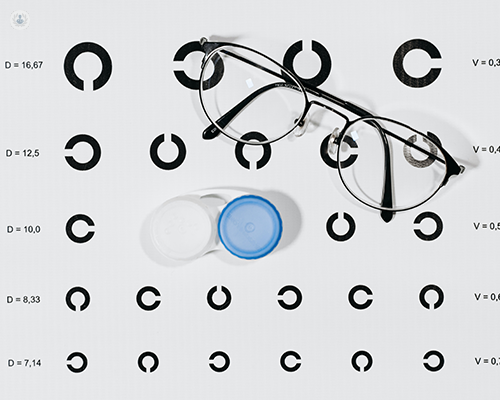PRK (photorefractive keratectomy)
Mr Alexander Ionides - Ophthalmology
Created on: 10-02-2020
Updated on: 09-11-2023
Edited by: Jay Staniland
What is photorefractive keratectomy?
Photorefractive keratectomy (PRK) is a type of laser refractive surgery that can be used to improve vision affected by refractive errors. A refractive error is when the eye cannot refract (bend) light correctly. PRK uses a laser to adjust the shape of the cornea, which improves how light focuses on the retina.

What can photorefractive keratectomy be used to treat?
Photorefractive keratectomy is a procedure performed by a specialist ophthalmologist that changes the shape of the cornea, the eye’s clear outer layer, so that rays of light can be better focused on the eye’s sensor layer (retina) which communicates images to the brain. This type of treatment can be effective in treating conditions where the eyes are impaired by the cornea’s shape, such as:
- near-sightedness (myopia)
- farsightedness (hyperopia)
- astigmatism
Who is suitable for photorefractive keratectomy treatment?
A specialist ophthalmologist will determine if photorefractive keratectomy can be beneficial for each individual patient, according to their eye and cornea health as well as their eye prescription.
The treatment is not suitable for patients also suffering from more serious eye conditions, such as cataracts or glaucoma. Scarring in the eyes as well as injuries to the cornea also make patients unsuitable for PRK treatment. Diseases that affect the body’s ability to heal as well as some allergies may also make the treatment unsuitable for some.
In order for photorefractive keratectomy treatment to be beneficial, the patient’s eye prescription should be unchanging for at least a year before the surgery.
How is photorefractive keratectomy performed?
Before undergoing the procedure, a specialist ophthalmologist will measure various factors including:
- the size of the pupils
- the refractive error
- the appearance and health of the cornea
- the general health of the eyes
PRK is a day-case procedure, meaning patients can go home after their treatment. During the procedure, the patient is kept awake but the eyes will be numbed using specialised eye drops.
While the eye is held open by a specialist piece of equipment, the outer most layer of the cornea (the epithelium) is removed. This can be done using a brush-type tool, a laser or a solution administered directly to the eye. This gives the surgeon access to the part of the cornea to be reshaped which is done with a laser. Once this is complete, various types of eye drops will be applied, including anti-inflammatories, antibiotics and steroids to aid recovery. Usually, to protect the eye, a clear contact lens is inserted which acts as a bandage. In total, the procedure usually takes between ten and fifteen minutes to complete.
What are the advantages of this type of procedure?
One of the greatest advantages of photorefractive keratectomy is its success rate. Around ninety per cent of patients enjoy twenty-twenty vision without the need for glasses or contact lenses after undergoing the procedure.
Patients with thin or uneven corneal surfaces are often unsuitable for similar treatments, such as LASIK surgery, but they can also benefit from the PRK procedure.
Are there any risks to photorefractive keratectomy?
As with any surgical procedure, patients undergoing photorefractive keratectomy run a very small risk of infection and scarring on the cornea. In very few cases, hazy vision or sensitivity to light may be experienced after the surgery.
Complications are extremely rare and nearly all patients go on to enjoy excellent vision. A small group of patients may find that the treatment becomes less effective over time or that they still require glasses or contact lenses (of a low prescription) to see fully.
What type of doctor performs photorefractive keratectomy?
Ophthalmologists specialising in ophthalmic surgery perform photorefractive keratectomy.
